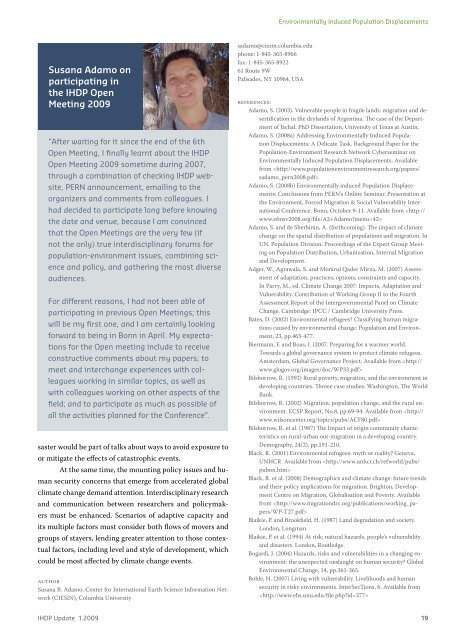Open - IHDP - United Nations University
Open - IHDP - United Nations University
Open - IHDP - United Nations University
Create successful ePaper yourself
Turn your PDF publications into a flip-book with our unique Google optimized e-Paper software.
Susana Adamo on<br />
participating in<br />
the <strong>IHDP</strong> <strong>Open</strong><br />
Meeting 2009<br />
“After waiting for it since the end of the 6th<br />
<strong>Open</strong> Meeting, I finally learnt about the <strong>IHDP</strong><br />
<strong>Open</strong> Meeting 2009 sometime during 2007,<br />
through a combination of checking <strong>IHDP</strong> website,<br />
PERN announcement, emailing to the<br />
organizers and comments from colleagues. I<br />
had decided to participate long before knowing<br />
the date and venue, because I am convinced<br />
that the <strong>Open</strong> Meetings are the very few (if<br />
not the only) true interdisciplinary forums for<br />
population-environment issues, combining science<br />
and policy, and gathering the most diverse<br />
audiences.<br />
For different reasons, I had not been able of<br />
participating in previous <strong>Open</strong> Meetings; this<br />
will be my first one, and I am certainly looking<br />
forward to being in Bonn in April. My expectations<br />
for the <strong>Open</strong> meeting include to receive<br />
constructive comments about my papers; to<br />
meet and interchange experiences with colleagues<br />
working in similar topics, as well as<br />
with colleagues working on other aspects of the<br />
field; and to participate as much as possible of<br />
all the activities planned for the Conference”.<br />
saster would be part of talks about ways to avoid exposure to<br />
or mitigate the effects of catastrophic events.<br />
At the same time, the mounting policy issues and human<br />
security concerns that emerge from accelerated global<br />
climate change demand attention. Interdisciplinary research<br />
and communication between researchers and policymakers<br />
must be enhanced. Scenarios of adaptive capacity and<br />
its multiple factors must consider both flows of movers and<br />
groups of stayers, lending greater attention to those contextual<br />
factors, including level and style of development, which<br />
could be most affected by climate change events.<br />
Author<br />
Susana B. Adamo, Center for International Earth Science Information Network<br />
(CIESIN), Columbia <strong>University</strong><br />
<strong>IHDP</strong> Update 1.2009<br />
sadamo@ciesin.columbia.edu<br />
phone: 1-845-365-8966<br />
fax: 1-845-365-8922<br />
61 Route 9W<br />
Palisades, NY 10964, USA<br />
Environmentally Induced Population Displacements<br />
rEFErENCEs:<br />
Adamo, S. (2003). Vulnerable people in fragile lands: migration and desertification<br />
in the drylands of Argentina. The case of the Department<br />
of Jáchal. PhD Dissertation, <strong>University</strong> of Texas at Austin.<br />
Adamo, S. (2008a) Addressing Environmentally Induced Population<br />
Displacements: A Delicate Task. Background Paper for the<br />
Population-Environment Research Network Cyberseminar on<br />
Environmentally Induced Population Displacements. Available<br />
from <br />
Adamo, S. (2008b) Environmentally induced Population Displacements:<br />
Conclusions from PERN’s Online Seminar. Presentation at<br />
the Environment, Forced Migration & Social Vulnerability International<br />
Conference. Bonn, October 9-11. Available from <br />
Adamo, S. and de Sherbinin, A. (forthcoming). The impact of climate<br />
change on the spatial distribution of populations and migration. In<br />
UN. Population Division. Proceedings of the Expert Group Meeting<br />
on Population Distribution, Urbanization, Internal Migration<br />
and Development.<br />
Adger, W., Agrawala, S. and Monirul Qader Mirza, M. (2007) Assessment<br />
of adaptation, practices, options, constraints and capacity.<br />
In Parry, M., ed. Climate Change 2007: Impacts, Adaptation and<br />
Vulnerability. Contribution of Working Group II to the Fourth<br />
Assessment Report of the Intergovernmental Panel on Climate<br />
Change. Cambridge: IPCC / Cambridge <strong>University</strong> Press.<br />
Bates, D. (2002) Environmental refugees? Classifying human migrations<br />
caused by environmental change. Population and Environment,<br />
23, pp.465-477.<br />
Biermann, F. and Boas, I. (2007. Preparing for a warmer world.<br />
Towards a global governance system to protect climate refugees.<br />
Amsterdam, Global Governance Project. Available from <br />
Bilsborrow, R. (1992) Rural poverty, migration, and the environment in<br />
developing countries. Threee case studies. Washington, The World<br />
Bank.<br />
Bilsborrow, R. (2002) Migration, population change, and the rural environment.<br />
ECSP Report, No.8, pp.69-94. Available from <br />
Bilsborrow, R. et al. (1987) The Impact of origin community characteristics<br />
on rural-urban out-migration in a developing country.<br />
Demography, 24(2), pp.191-210.<br />
Black, R. (2001) Environmental refugees: myth or reality? Geneva,<br />
UNHCR. Available from <br />
Black, R. et al. (2008) Demographics and climate change: future trends<br />
and their policy implications for migration. Brighton, Development<br />
Centre on Migration, Globalisation and Poverty. Available<br />
from <br />
Blaikie, P. and Brookfield, H. (1987) Land degradation and society.<br />
London, Longman.<br />
Blaikie, P. et al. (1994) At risk: natural hazards, people’s vulnerability<br />
and disasters. London, Routledge.<br />
Bogardi, J. (2004) Hazards, risks and vulnerabilities in a changing environment:<br />
the unexpected onslaught on human security? Global<br />
Environmental Change, 14, pp.361-365.<br />
Bohle, H. (2007) Living with vulnerability. Livelihoods and human<br />
security in risky environments. InterSecTions, 6. Available from<br />
<br />
19
















